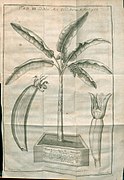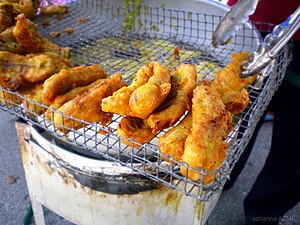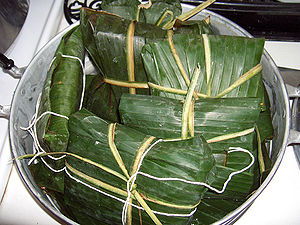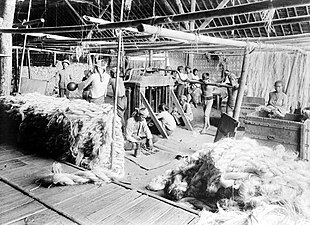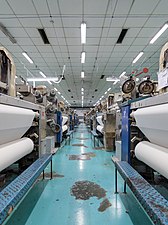Banana
| Banana | |
|---|---|
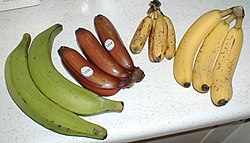 Fruits of four different cultivars. Left to right: plantain, red banana, apple banana, and Cavendish banana | |
| Source plant(s) | Musa |
| Part(s) of plant | Fruit |
| Uses | Food |
A banana is an elongated, edible
Musa species are native to tropical
Worldwide, there is no sharp distinction between dessert "bananas" and cooking "plantains": this works well enough in the Americas and Europe, but it breaks down in Southeast Asia where many more kinds of bananas are grown and eaten. The term "banana" is applied also to other members of the genus Musa, such as the scarlet banana (Musa coccinea), the pink banana (Musa velutina), and the Fe'i bananas. Members of the genus Ensete, such as the snow banana (Ensete glaucum) and the economically important false banana (Ensete ventricosum) of Africa are sometimes included. Both genera are in the banana family, Musaceae.
Banana plantations are subject to damage by parasitic nematodes and insect pests, and to fungal and bacterial diseases, one of the most serious being Panama disease which is caused by a Fusarium fungus. This and black sigatoka threaten the production of Cavendish bananas, the main variety eaten in the Western world. Plant breeders are seeking new varieties, but these are difficult to breed given that commercial varieties are seedless. To enable future breeding, banana germplasm is conserved in multiple gene banks around the world.
Description
The banana plant is the largest
The leaves of banana plants are composed of a stalk (
The banana fruits develop from the banana heart, in a large hanging cluster called a bunch, made up of around 9 tiers called hands, with up to 20 fruits to a hand. A bunch can weigh 22–65 kilograms (49–143 lb).[10]
The fruit has been described as a "leathery berry".
-
A corm, about 25 cm (10 in) across
-
Young plant
-
Female flowers have petals at the tip of the ovary
-
'Tree' showing fruit and inflorescence
-
Single row planting
-
Inflorescence, partially opened
Evolution
Phylogeny
A 2011 phylogenomic analysis using nuclear genes indicates the
| Musaceae |
| |||||||||||||||||||||||||||||||||||||||||||||||||||||||||||||||
- ‡ Many cultivated bananas are hybrids of M. acuminata x M. balbisiana (not shown in tree).[15]
Work by Li and colleagues in 2024 identifies three subspecies of M. acuminata, namely sspp. banksii, malaccensis, and zebrina, as contributing substantially to the Ban, Dh, and Ze subgenomes of
Taxonomy
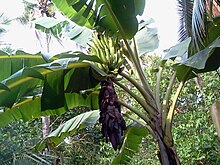
The genus Musa was created by Carl Linnaeus in 1753.[17] The name may be derived from Antonius Musa, physician to the Emperor Augustus, or Linnaeus may have adapted the Arabic word for banana, mauz.[18] The ultimate origin of musa may be in the Trans–New Guinea languages, which have words similar to "#muku"; from there the name was borrowed into the Austronesian languages and across Asia, accompanying the cultivation of the banana as it was brought to new areas, via the Dravidian languages of India, into Arabic as a Wanderwort.[19] The word "banana" is thought to be of West African origin, possibly from the Wolof word banaana, and passed into English via Spanish or Portuguese.[20]
Musa is the type genus in the family
The classification of cultivated bananas has long been a problematic issue for taxonomists. Linnaeus originally placed bananas into two species based only on their uses as food: Musa sapientum for dessert bananas and Musa paradisiaca for
In a series of papers published from 1947 onwards, Ernest Cheesman showed that Linnaeus's Musa sapientum and Musa paradisiaca were cultivars and descendants of two wild seed-producing species, Musa acuminata and Musa balbisiana, both first described by Luigi Aloysius Colla.[23] Cheesman recommended the abolition of Linnaeus's species in favor of reclassifying bananas according to three morphologically distinct groups of cultivars – those primarily exhibiting the botanical characteristics of Musa balbisiana, those primarily exhibiting the botanical characteristics of Musa acuminata, and those with characteristics of both.[22] Researchers Norman Simmonds and Ken Shepherd proposed a genome-based nomenclature system in 1955. This system eliminated almost all the difficulties and inconsistencies of the earlier classification of bananas based on assigning scientific names to cultivated varieties. Despite this, the original names are still recognized by some authorities, leading to confusion.[23][24]
The accepted scientific names for most groups of cultivated bananas are Musa acuminata Colla and Musa balbisiana Colla for the ancestral species, and Musa × paradisiaca L. for the hybrid of the two.[15]
Informal classification
In regions such as North America and Europe, Musa fruits offered for sale can be divided into small sweet "bananas" eaten raw when ripe as a dessert, and large starchy "plantains" or
The cooking bananas of East Africa however belong to a different group, the
History
Domestication
The earliest domestication of bananas (
Spread
From Island Southeast Asia, bananas became part of the staple domesticated crops of
These ancient introductions resulted in the banana subgroup now known as the
Another wave of introductions later spread bananas to other parts of tropical Asia, particularly Indochina and the Indian subcontinent.
Arab Agricultural Revolution
The banana may have been present in isolated locations elsewhere in the Middle East on the eve of Islam. The spread of Islam was followed by far-reaching diffusion. There are numerous references to it in Islamic texts (such as poems and hadiths) beginning in the 9th century. By the 10th century the banana appears in texts from Palestine and Egypt. From there it diffused into North Africa and Muslim Iberia during the Arab Agricultural Revolution.[41][42] An article on banana tree cultivation is included in Ibn al-'Awwam's 12th-century agricultural work, Kitāb al-Filāḥa (Book on Agriculture).[43] During the Middle Ages, bananas from Granada were considered among the best in the Arab world.[42] Bananas were certainly grown in the Christian Kingdom of Cyprus by the late medieval period. Writing in 1458, the Italian traveller and writer Gabriele Capodilista wrote favourably of the extensive farm produce of the estates at Episkopi, near modern-day Limassol, including the region's banana plantations.[44]
Columbian exchange
Bananas were encountered by European explorers during the
-
Originalnative ranges of the ancestors of modern edible bananas. Musa acuminata (green), Musa balbisiana (orange)[50]
-
Fruits of wild-type bananas have numerous large, hard seeds.
-
Actual and probable diffusion of bananas during the Arab Agricultural Revolution (700–1500 CE)[42]
-
Illustration of fruit and plant from Acta Eruditorum, 1734
Plantation cultivation

In the 15th and 16th centuries, Portuguese colonists started banana plantations in the Atlantic Islands, Brazil, and western Africa.
Peasant cultivation

The vast majority of the world's bananas are cultivated for family consumption or for sale on local markets. India is the world leader in this sort of production, but many other Asian and African countries where climate and soil conditions allow cultivation also host large populations of banana growers who sell at least some of their crop.[56] Peasants with smallholdings of 1 to 2 acres in the Caribbean produce bananas for the world market, often alongside other crops.[57]
Modern cultivation
Bananas are propagated asexually from offshoots. The plant is allowed to produce two shoots at a time; a larger one for immediate fruiting and a smaller "sucker" or "follower" to produce fruit in 6–8 months.[8] As a non-seasonal crop, bananas are available fresh year-round.[58] They are grown in some 135 countries.[59]
Cavendish
In global commerce in 2009, by far the most important cultivars belonged to the triploid AAA group of Cavendish group bananas.[60] It is unclear if any existing cultivar can replace Cavendish bananas, so various hybridisation and genetic engineering programs are attempting to create a disease-resistant, mass-market banana. One such strain that has emerged is the Taiwanese Cavendish or Formosana.[61]
Ripening

Export bananas are picked green, and ripened in special rooms upon arrival in the destination country. These rooms are air-tight and filled with
Storage and transport
Bananas are transported over long distances from the tropics to world markets.[65] To obtain maximum shelf life, harvest comes before the fruit is mature. The fruit requires careful handling, rapid transport to ports, cooling, and refrigerated shipping. The goal is to prevent the bananas from producing their natural ripening agent, ethylene. This technology allows storage and transport for 3–4 weeks at 13 °C (55 °F). On arrival, bananas are held at about 17 °C (63 °F) and treated with a low concentration of ethylene. After a few days, the fruit begins to ripen and is distributed for final sale. Ripe bananas can be held for a few days at home. If bananas are too green, they can be put in a brown paper bag with an apple or tomato overnight to speed up the ripening process.[66]
Sustainability
The excessive use of fertilizers contributes greatly to
Breeding
The
Production and export
World
| Bananas | Plantains | Total | |
|---|---|---|---|
| 34.5 | 34.5 | ||
| 11.8 | 11.8 | ||
| 10.4 | 10.4 | ||
| 9.2 | 9.2 | ||
| 5.9 | 3.1 | 9.0 | |
| 8.0 | 8.0 | ||
| 6.1 | 0.9 | 6.9 | |
| 6.9 | 6.9 | ||
| 0.8 | 4.9 | 5.7 | |
| 0.9 | 4.7 | 5.5 | |
| 2.5 | 2.5 | 5.0 | |
| 4.8 | 0.3 | 5.0 | |
| 0.1 | 4.8 | 4.9 | |
| 4.6 | 4.6 | ||
| 3.5 | 0.6 | 4.1 | |
| 2.2 | 0.9 | 3.1 | |
| 2.5 | 0.1 | 2.6 | |
| 0.5 | 2.1 | 2.6 | |
| 2.6 | 2.6 | ||
| 1.4 | 1.2 | 2.5 | |
| 2.5 | 2.5 | ||
| 2.4 | 2.4 | ||
| World | 135.1 | 44.2 | 179.3 |
| Source: FAOSTAT of the United Nations[72] Note: Some countries distinguish between bananas and plantains, but four of the top six producers do not, thus necessitating comparisons using the total for bananas and plantains combined.
| |||
Bananas are exported in larger volume and to a larger value than any other fruit.[61] In 2022, world production of bananas and plantains combined was 179 million tonnes, led by India and China with a combined total of 26% of global production. Other major producers were Uganda, Indonesia, the Philippines, Nigeria and Ecuador.[72] As reported for 2013, total world exports were 20 million tonnes of bananas and 859,000 tonnes of plantains.[73] Ecuador and the Philippines were the leading exporters with 5.4 and 3.3 million tonnes, respectively, and the Dominican Republic was the leading exporter of plantains with 210,350 tonnes.[73]
Developing countries
Bananas and plantains are a major staple food crop for millions of people in developing countries. In many tropical countries, the main cultivars produce green (unripe) bananas used for cooking. Most producers are small-scale farmers either for home consumption or local markets. Because bananas and plantains produce fruit year-round, they provide a valuable food source during the hunger season between harvests of other crops. Bananas and plantains are thus important for global food security.[74]
Pests
Nematodes
Banana roots are subject to damage from multiple species of parasitic
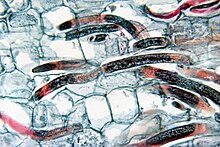
Insects
Among the main insect pests of banana cultivation are two beetles that cause substantial economic losses, the banana borer Cosmopolites sordidus and the banana stem weevil Odoiporus longicollis. Other significant pests include aphids and scarring beetles.[79]

Diseases
Although in no danger of outright extinction, bananas of the Cavendish group, which dominate the global market, are under threat. Its predecessor '
Some commentators have remarked that those variants which could replace what much of the world considers a "typical banana" are so different that most people would not consider them the same fruit, and blame the decline of the banana on
Panama disease
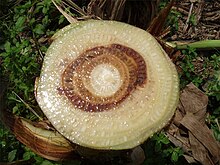
Panama disease is caused by a Fusarium soil fungus, which enters the plants through the roots and travels with water into the trunk and leaves, producing gels and gums that cut off the flow of water and nutrients, causing the plant to wilt, and exposing the rest of the plant to lethal amounts of sunlight. Prior to 1960, almost all commercial banana production centered on the Gros Michel cultivar, which was highly susceptible.[84] Cavendish was chosen as the replacement for Gros Michel because, among resistant cultivars, it produces the highest quality fruit. However, more care is required for shipping the Cavendish,[85] and its quality compared to Gros Michel is debated.[86]
Fusarium wilt TR4
Black sigatoka

Banana bunchy top virus

Banana bunchy top virus (BBTV) is a plant virus of the genus Babuvirus, family Nanonviridae affecting Musa spp. (including banana, abaca, plantain and ornamental bananas) and Ensete spp. in the family Musaceae.[94] Banana bunchy top disease (BBTD) symptoms include dark green streaks of variable length in leaf veins, midribs and petioles. Leaves become short and stunted as the disease progresses, becoming 'bunched' at the apex of the plant. Infected plants may produce no fruit or the fruit bunch may not emerge from the pseudostem.[95] The virus is transmitted by the banana aphid Pentalonia nigronervosa and is widespread in SE Asia, Asia, the Philippines, Taiwan, Oceania and parts of Africa. There is no cure for BBTD, but it can be effectively controlled by the eradication of diseased plants and the use of virus-free planting material.[96] No resistant cultivars have been found, but varietal differences in susceptibility have been reported. The commercially important Cavendish subgroup is severely affected.[95]
Banana bacterial wilt
Banana bacterial wilt (BBW) is a bacterial disease caused by Xanthomonas campestris pv. musacearum.[97] First identified on a close relative of bananas, Ensete ventricosum, in Ethiopia in the 1960s,[98] BBW occurred in Uganda in 2001 affecting all banana cultivars. Since then BBW has been diagnosed in Central and East Africa including the banana growing regions of Rwanda, the Democratic Republic of the Congo, Tanzania, Kenya, Burundi, and Uganda.[99]
Conservation of genetic diversity

Given the narrow range of
Banana
Genes from wild banana species are conserved as
Nutrition
| Nutritional value per 100 g (3.5 oz) | |
|---|---|
| Energy | 371 kJ (89 kcal) |
22.84 g | |
| Sugars | 12.23 g |
| Dietary fiber | 2.6 g |
0.33 g | |
1.09 g | |
Niacin (B3) | 4% 0.665 mg |
| Pantothenic acid (B5) | 7% 0.334 mg |
| Vitamin B6 | 24% 0.4 mg |
| Folate (B9) | 5% 20 μg |
| Choline | 2% 9.8 mg |
| Vitamin C | 10% 8.7 mg |
| Minerals | Quantity %DV† |
| Iron | 1% 0.26 mg |
| Magnesium | 6% 27 mg |
| Manganese | 12% 0.27 mg |
| Phosphorus | 2% 22 mg |
| Potassium | 12% 358 mg |
| Sodium | 0% 1 mg |
| Zinc | 1% 0.15 mg |
| Other constituents | Quantity |
| Water | 74.91 g |
Link to USDA Database entry
values are for edible portion | |
| †Percentages estimated using US recommendations for adults,[104] except for potassium, which is estimated based on expert recommendation from the National Academies.[105] | |
A raw banana (not including the peel) is 75% water, 23%
Although bananas are commonly thought to contain exceptional potassium content,[106][107] their actual potassium content is not high per typical food serving, having only 12% of the Daily Value for potassium (considered a moderate level of the DV; table). The potassium-content ranking for bananas among fruits, vegetables, legumes, and many other foods is relatively medium.[108][109]
Individuals with a latex allergy may experience a reaction to bananas.[110]
Uses
Culinary
Fruit
Bananas are a staple starch for many tropical populations. Depending upon cultivar and ripeness, the flesh can vary in taste from starchy to sweet, and texture from firm to mushy. Both the skin and inner part can be eaten raw or cooked. The primary component of the aroma of fresh bananas is isoamyl acetate (also known as banana oil), which, along with several other compounds such as butyl acetate and isobutyl acetate, is a significant contributor to banana flavor.[111]
Plantains are eaten cooked, such as made into fritters.
-
Banana curry with lemon, Andhra Pradesh, India
-
Pisang goreng fried banana in batter, a popular snack in Indonesia
-
Banana in sweet gravy, known as pengat pisang in Malaysia
Flowers
Banana flowers (also called "banana hearts" or "banana blossoms") are used as a
-
Banana flowers and leaves on sale in Thailand
-
Kilawin na pusô ng saging, aFilipino dishof banana flowers
Leaf
Banana leaves are large, flexible, and waterproof. While generally too tough to actually be eaten, they are often used as ecologically friendly disposable food containers or as "plates" in South Asia and several Southeast Asian countries.[120] In Indonesian cuisine, banana leaf is employed in cooking methods like pepes and botok; banana leaf packages containing food ingredients and spices are cooked in steam or in boiled water, or are grilled on charcoal. Certain types of tamales are wrapped in banana leaves instead of corn husks.[121]
When used so for steaming or grilling, the banana leaves protect the food ingredients from burning and add a subtle sweet flavor.[1] In South India, it is customary to serve traditional food on a banana leaf.[122] In Tamil Nadu (India), dried banana leaves are used as to pack food and to make cups to hold liquid food items.[123]
-
Banana leaf as disposable plate forchicken satay in Java
-
Nicaraguan Nacatamales, in banana leaves, ready to be steamed
Trunk
The tender core of the banana plant's trunk is also used in
-
Kaeng yuak, a northern Thai curry of the core of the banana plant
Paper and textiles
Banana fiber harvested from the pseudostems and leaves has been used for textiles in Asia since at least the 13th century. Both fruit-bearing and fibrous banana species have been used.[126] In the Japanese system Kijōka-bashōfu, leaves and shoots are cut from the plant periodically to ensure softness. Harvested shoots are first boiled in lye to prepare fibers for yarn-making. These banana shoots produce fibers of varying degrees of softness, yielding yarns and textiles with differing qualities for specific uses. For example, the outermost fibers of the shoots are the coarsest, and are suitable for tablecloths, while the softest innermost fibers are desirable for kimono and kamishimo. This traditional Japanese cloth-making process requires many steps, all performed by hand.[127] Banana paper can be made either from the bark of the banana plant, mainly for artistic purposes, or from the fibers of the stem and non-usable fruits. The paper may be hand-made or industrially processed.[128]
-
Packing Manila hemp (Musa textilis) into bales, Java
-
Weaving looms processing Manila hemp fabric
-
A modernManila hempbag by the fashion company QWSTION
Other uses
The large leaves of bananas may also be used as umbrellas.[1]
Waste bananas can be used to feed livestock.[131]As with all living things, potassium-containing bananas emit
Cultural roles
Arts
The Edo period poet Matsuo Bashō is named after the Japanese word 芭蕉 (Bashō) for the Japanese banana. The Bashō planted in his garden by a grateful student became a source of inspiration to his poetry, as well as a symbol of his life and home.[134]
The song "Yes! We Have No Bananas" was written by Frank Silver and Irving Cohn and originally released in 1923; for many decades, it was the best-selling sheet music in history. Since then the song has been rerecorded several times and has been particularly popular during banana shortages.[135][136]
A person slipping on a banana peel has been a staple of physical comedy for generations. An American comedy recording from 1910 features a popular character of the time, "Uncle Josh", claiming to describe his own such incident.[137]
The cover artwork for the debut album of The Velvet Underground features a banana made by Andy Warhol. On the original vinyl LP version, the design allowed the listener to "peel" this banana to find a pink, peeled phallic banana on the inside.[138]
Italian artist Maurizio Cattelan created a concept art piece titled Comedian[139] involving taping a banana to a wall using silver duct tape. The piece was exhibited briefly at the Art Basel in Miami before being removed from the exhibition and eaten without permission in another artistic stunt titled Hungry Artist by New York artist David Datuna.[140]
Religion and folklore

In India, bananas serve a prominent part in many festivals and occasions of
In Thailand, it is believed that a certain type of banana plant may be inhabited by a spirit, Nang Tani, a type of ghost related to trees and similar plants that manifests itself as a young woman.[143] Often people tie a length of colored satin cloth around the pseudostem of the banana plants.[144]
In
See also
- Banana (slur), the use of the word and actual fruit as an insult
- Corporación Bananera Nacional
- Domesticated plants and animals of Austronesia
- Orange, another fruit exported and consumed in large quantities
- United Brands Company v Commission of the European Communities
References
- ^ from the original on April 15, 2009 – via www.hort.purdue.edu.
- ISBN 978-2-910810-37-5. Archived from the original(PDF) on April 11, 2013. Retrieved January 31, 2013.
- ^ a b c Stover & Simmonds 1987, pp. 5–17.
- ^ Stover & Simmonds 1987, p. 212.
- Appleton-Century Company. p. 49 (photo with caption).
- Springer Verlag. p. 149.
- ^ a b Ploetz et al. 2007, p. 12.
- ^ a b Stover & Simmonds 1987, pp. 244–247.
- ^ Office of the Gene Technology Regulator 2008.
- ^ "Banana plant". Britannica. Retrieved March 12, 2024.
- ISBN 978-0-916422-07-3.
- ^ Warkentin, Jon (2004). "How to make a Banana Split". University of Manitoba. Archived from the original on July 29, 2014. Retrieved July 21, 2014.
- from the original on June 8, 2013. Retrieved June 11, 2011.
- PMID 21496296.
- ^ a b "Musa paradisiaca". World Checklist of Selected Plant Families. Royal Botanic Gardens, Kew. Archived from the original on April 29, 2013. Retrieved January 6, 2013.
- PMID 38082204.
- ^ a b Search for "Musa", "World Checklist of Selected Plant Families". Royal Botanic Gardens, Kew. Archived from the original on May 17, 2008. Retrieved January 6, 2013.
- ISBN 978-0-19-866189-4.
- ISBN 978-90-272-1255-9. which (p. 169) cites Blench, Roger (2016). "Things your classics master never told you: a borrowing from Trans New Guinea languages into Latin". Academia.edu.
- ^ "Banana". Online Etymology Dictionary. Archived from the original on July 28, 2011. Retrieved August 5, 2010.
- ^ Bailey, Liberty Hyde (1916). The Standard Cyclopedia of Horticulture. Macmillan. pp. 2076–2079. Archived from the original on February 22, 2017.
- ^ a b Valmayor et al. 2000.
- ^ a b Constantine, D.R. "Musa paradisiaca". Archived from the original on September 5, 2008. Retrieved September 5, 2014.
- ^ Porcher, Michel H. (July 19, 2002). "Sorting Musa names". The University of Melbourne. Archived from the original on March 2, 2011. Retrieved January 11, 2011.
- ^ a b Valmayor et al. 2000, p. 2.
- ^ Ploetz et al. 2007, pp. 18–19.
- PMID 19691321.
- ^ Valmayor et al. 2000, pp. 8–12.
- ^ Englberger, Lois (2003). "Carotenoid-rich bananas in Micronesia" (PDF). InfoMusa. 12 (2): 2–5. Archived from the original (PDF) on March 9, 2016. Retrieved January 22, 2013.
- ^ Nelson, Ploetz & Kepler 2006.
- ^ S2CID 36818517.
- ^ .
- ^ (PDF) from the original on October 9, 2022.
- ^ S2CID 140588504.
- doi:10.1006/jasc.1999.0447. Archived from the original(PDF) on January 14, 2012. Retrieved January 20, 2019.
- ^ Zeller, Friedrich J. (2005). "Herkunft, Diversität und Züchtung der Banane und kultivierter Zitrusarten (Origin, diversity and breeding of banana and cultivated citrus)" (PDF). Journal of Agriculture and Rural Development in the Tropics and Subtropics, Supplement 81 (in German). Archived (PDF) from the original on March 4, 2016. Retrieved September 5, 2014.
- doi:10.1016/j.jas.2005.06.015. Archived from the original(PDF) on December 2, 2007.
- ISBN 978-1-85065-947-1.
- PMID 33419922.
- ^ Ploetz et al. 2007, p. 7.
- S2CID 154359726.
- ^ ISBN 978-0-521-24711-5.
- -370 (Article XLVIII)
- ISBN 978-0-8147-4181-8.
- S2CID 225586504.
- OCLC 347382.
- ^ Gibson, Arthur C. "Bananas and plantains". UCLA. Archived from the original on June 14, 2012. Retrieved September 5, 2014.
- JSTOR 41888470.
- ^ Peed, Mike (January 10, 2011). "We Have No Bananas: Can Scientists Defeat a Devastating Blight?". The New Yorker. pp. 28–34. Archived from the original on January 7, 2011. Retrieved January 13, 2011.
- ISBN 978-0-203-20338-5. Archivedfrom the original on February 22, 2017.
- ISBN 978-0470016176.
- ^ a b "Phora Ltd. – History of Banana". Phora-sotoby.com. Archived from the original on April 16, 2009. Retrieved April 16, 2009.
- ^ ISBN 978-0-452-29008-2.
- ^ a b "Big-business greed killing the banana – Independent". The New Zealand Herald. May 24, 2008. p. A19.
- ^ "Banana Market". University of Florida, IFAS Extension. Archived from the original on June 14, 2021. Retrieved March 23, 2024.
- ^ Office of the Gene Technology Regulator 2008, pp. 7–8.
- ^ Clegg, Peter "The Development of the Windward Islands Banana Export Trade: Commercial Opportunity and Colonial Necessity," Society for Caribbean Studies Annual Conference Papers 1 (2000).
- ^ "How bananas are grown". Banana Link. Archived from the original on September 6, 2016. Retrieved September 2, 2016.
- ^ "Where bananas are grown". ProMusa. 2013. Archived from the original on October 25, 2016. Retrieved October 24, 2016.
- ^ "Apples and oranges are the top U.S. fruit choices". USDA Economic Research Service. Retrieved February 13, 2023.
- ^ a b Gittleson, Kim (February 1, 2018). "Battling to save the world's bananas". BBC News. Archived from the original on March 26, 2018. Retrieved April 18, 2018.
- ^ a b "Fruit Ripening". Archived from the original on July 21, 2011. Retrieved February 17, 2010.
- ^ a b "Ethylene Process". Argonne National Laboratory. Archived from the original on March 24, 2010. Retrieved February 17, 2010.
- S2CID 83844509. Archived from the original(PDF) on March 16, 2012. Retrieved July 16, 2011.
- ISBN 978-9251050576.
- ^ "How to Ripen Bananas". Chiquita. Archived from the original on August 4, 2009. Retrieved August 15, 2009.
- ^ Cohen, Rebecca (June 12, 2009). "Global issues for breakfast: The banana industry and its problems FAQ (Cohen mix)". SCQ. Archived from the original on June 5, 2020. Retrieved June 5, 2020.
- ^ Voora, V.; Larrea, C.; Bermudez, S. (2020). Global Market Report: Bananas. State of Sustainability Initiatives (Report).
- S2CID 249207968.
- S2CID 247265619. Chinese Academy of Agricultural Sciences via KeAi Communications Co. Ltd. – Chinese Society for Horticultural Science and Institute of Vegetables and Flowers.
- ^ Pearce, Fred (January 18, 2003). "Going bananas" (PDF). New Scientist. 177 (2378): 27. Archived (PDF) from the original on February 17, 2020.
- ^ a b "FAOSTAT". www.fao.org. Retrieved March 16, 2024.
- ^ a b "Banana and plantain exports in 2013, Crops and livestock products/Regions/World list/Export quantity (pick lists)". Food and Agriculture Organization, Corporate Statistical Database (FAOSTAT). 2017. Archived from the original on May 11, 2017. Retrieved January 6, 2018.
- PMID 22801500.
- ^ Sekora, N. S. and W. T. Crow. Burrowing nematode, Radopholus similis. EENY-542. University of Florida IFAS. 2012.
- ^ Jonathan, E. I.; Rajendran, G. (2000). "Pathogenic effect of root-knot nematode, Meloidogyne incognita on banana, Musa sp". Indian Journal of Nematology. 30 (1): 13–15.
- ISSN 1388-5545.
- .
- ^ ISBN 978-981-10-8686-1.
- ^ "A future with no bananas?". New Scientist. May 13, 2006. Archived from the original on January 18, 2021. Retrieved December 9, 2006.
- ^ Montpellier, Emile Frison (February 8, 2003). "Rescuing the banana". New Scientist. Archived from the original on March 11, 2007. Retrieved December 9, 2006.
- ISSN 0362-4331. Retrieved October 21, 2022.
- ISSN 1543-5938.
- ^ Barker, C.L. (November 2008). "Conservation: Peeling Away". National Geographic Magazine.
- ^ Frost, Natasha (February 28, 2018). "A Quest for the Gros Michel, the Great Banana of Yesteryear". Atlas Obscura. Archived from the original on July 24, 2020. Retrieved July 24, 2019.
- ISBN 978-0963316103.
- ^ a b c d Karp, Myles (August 12, 2019). "The banana is one step closer to disappearing". National Geographic. Archived from the original on September 13, 2019. Retrieved September 14, 2019.
- ^ "Risk assessment of Eastern African Highland Bananas and Plantains against TR4" (PDF). International Banana Symposium. 2012. Archived from the original (PDF) on April 7, 2014. Retrieved April 6, 2014.
- ^ PMID 29133817.
- ^ a b "Researchers Develop Cavendish Bananas Resistant to Panama Disease". ISAAA (International Service for the Acquisition of Agri-biotech Applications) Crop Biotech Update. February 24, 2021. Retrieved September 2, 2021.
- ^ Holmes, Bob (April 20, 2013). "Go Bananas". New Scientist. 218 (2913): 9–41. (Also at Holmes, Bob (April 20, 2013). "Nana from heaven? How our favourite fruit came to be". New Scientist. Archived from the original on April 24, 2013. Retrieved April 19, 2013.)
- PMID 30812750.
- ^ "Mycosphaerella fijiensis v2.0". Joint Genome Institute, U.S. Department of Energy. 2013. Archived from the original on February 28, 2014. Retrieved August 13, 2013.
- ^ National Biological Information Infrastructure & IUCN/SSC Invasive Species Specialist Group. Banana Bunchy Top Virus Archived April 22, 2016, at the Wayback Machine. Global Invasive Species Database. N.p., July 6, 2005.
- ^ a b Thomas, JE (ed). 2015. MusaNet Technical Guidelines for the Safe Movement of Musa Germplasm Archived September 28, 2018, at the Wayback Machine. 3rd edition. MusaLit, Bioversity International, Rome
- INIBAP. Archived(PDF) from the original on October 2, 2018. Retrieved October 2, 2018.
- .
- Phytopathology. 58: 111–112.
- .
- ^ Genebank Platform. 2018. Archivedfrom the original on September 10, 2018. Retrieved September 10, 2018.
- ^ McGrath, Matt (March 12, 2024). "Banana prices to go up as temperatures rise, says expert". BBC News. Retrieved March 12, 2024.
- ^ "International Musa Germplasm Transit Centre". Bioversity International. 2018. Archived from the original on September 10, 2018. Retrieved September 10, 2018.
- Montpellier, France: Bioversity International. 2016.
- ^ United States Food and Drug Administration (2024). "Daily Value on the Nutrition and Supplement Facts Labels". Retrieved March 28, 2024.
- )
- ^ Canadian Coalition for Nuclear Responsibility. Archived(PDF) from the original on May 15, 2017. Retrieved April 24, 2019.
- ^ Kraft, S. (August 4, 2011). "Bananas! Eating Healthy Will Cost You; Potassium Alone $380 Per Year". Medical News Today. Archived from the original on October 25, 2014. Retrieved October 25, 2014.
- ^ "Ranking of potassium content per 100 grams in common foods ("Foundation" only for search filter)". FoodData Central, United States Department of Agriculture. 2023. Retrieved February 26, 2023.
- ^ "What you need to know about potassium". EatRight Ontario, Dietitians of Canada. 2019. Archived from the original on May 3, 2019. Retrieved April 24, 2019.
- S2CID 24748498.
- PMID 11902928. "Isoamyl acetate (9.6%) imparts the characteristic aroma typical of fresh bananas (13, 17−20), while butyl acetate (8.1%) and isobutyl acetate (1.4%) are considered to be character impact compounds of banana flavor."
- ^ Williams, Patrick. "Roast bream with fried plantain fritters and coconut sauce". BBC. Retrieved March 12, 2024.
- ISBN 978-1-59884-955-4.
- ^ Tsao, Kimberley (February 15, 2023). "Turon, maruya, bitso-bitso and banana cue make it to Taste Atlas's list of 100 most popular deep-fried desserts in the world". GMA News. Retrieved March 12, 2024.
- .
- ^ Pereira, Ignatius (April 13, 2013). "The taste of Kerala". The Hindu. Chennai, India. Archived from the original on December 28, 2013. Retrieved January 3, 2014.
- ^ Coghlan, Lea (May 13, 2014). "Business goes bananas". Queensland Country Life.
- ISBN 978-0-85561-688-5. Archived from the originalon June 3, 2008. Retrieved May 17, 2008.
- ^ Watson, Molly (June 21, 2022). "Banana Flowers". The Spruce Eats. Archived from the original on May 14, 2014. See also the link on that page for Banana Flower Salad.
- ^ Nace, Trevor (March 25, 2019). "Thailand Supermarket Ditches Plastic Packaging For Banana Leaves". Forbes. Archived from the original on March 26, 2019. Retrieved March 26, 2019.
- ^ "Banana leaves transform texture of chicken tamales". The San Diego Union-Tribune. December 7, 2022.
- ^ Grover, Neha (December 27, 2022). "Why South Indians Eat On Banana Leaves - Health Benefits And More". NDTV. Retrieved March 12, 2024.
- ISSN 2522-8307.
- ISBN 9786214200870.
- ISBN 9786214200870.
- ISBN 978-9058676146. Archivedfrom the original on March 27, 2018.
- ^ "Traditional Crafts of Japan – Kijoka Banana Fiber Cloth". Association for the Promotion of Traditional Craft Industries. Archived from the original on November 4, 2006. Retrieved December 11, 2006.
- ISBN 9781482257984. Archivedfrom the original on March 27, 2018.
- ^ Minard, Anne (March 11, 2011). "Is That a Banana in Your Water?". National Geographic. Archived from the original on April 26, 2011. Retrieved March 15, 2011.
- from the original on December 22, 2019. Retrieved September 3, 2019.
- ^ Heuzé, V.; Tran, G.; Archimède, H.; Renaudeau, D.; Lessire, M. (2016). "Banana fruits". Feedipedia, a programme by INRA, CIRAD, AFZ and FAO. Archived from the original on February 21, 2018. Retrieved February 20, 2018. Last updated on March 25, 2016, 10:36
- ^ Frame, Paul (January 20, 2009). "General information about K-40". Oak Ridge National Laboratory. Archived from the original on December 23, 2017. Retrieved April 24, 2019.
- ^ Mansfield, Gary (March 7, 1995). "Banana equivalent dose". Internal Dosimetry, Lawrence Livermore National Laboratory, University of California. Archived from the original on August 17, 2011. Retrieved April 24, 2019.
- ISBN 978-0-8047-3099-0.
- ISBN 9780195060829. Archivedfrom the original on February 23, 2017.
- ^ Dan Koeppel (2005). "Can This Fruit Be Saved?". Popular Science. 267 (2): 60–70. Archived from the original on February 22, 2017.
- ^ Stewart, Cal. "Collected Works of Cal Stewart part 2". Uncle Josh in a Department Store (1910). The Internet Archive. Retrieved November 17, 2010.
- ^ Bill DeMain (December 11, 2011). "The Stories Behind 11 Classic Album Covers". mental_floss. Archived from the original on October 28, 2012. Retrieved January 6, 2013.
- from the original on December 30, 2019. Retrieved December 25, 2019.
- from the original on December 15, 2019. Retrieved December 25, 2019.
- ^ "Banana trees in weddings". Indian Mirror. Archived from the original on August 24, 2019. Retrieved August 24, 2019.
- ^ "Legends, myths and folklore of the banana tree in India - its use in traditional culture". EarthstOriez. May 2, 2017. Archived from the original on August 24, 2019. Retrieved August 24, 2019.
- ^ "Banana Tree Prai Lady Ghost". Thailand-amulets.net. March 19, 2012. Archived from the original on November 8, 2012. Retrieved August 26, 2012.
- ^ "Spirits". Thaiworldview.com. Archived from the original on June 30, 2012. Retrieved August 26, 2012.
- ^ "Pontianak- South East Asian Vampire". Castleofspirits.com. Archived from the original on July 20, 2014. Retrieved May 13, 2014.
Bibliography
- Nelson, S.C.; Ploetz, R.C.; Kepler, A.K. (2006). "Musa species (bananas and plantains)" (PDF). In Elevitch, C.R (ed.). Species Profiles for Pacific Island Agroforestry. Hōlualoa, Hawai'i: Permanent Agriculture Resources. Archived (PDF) from the original on February 28, 2014. Retrieved January 10, 2013.
- Office of the Gene Technology Regulator (2008). The Biology of Musa L. (banana) (PDF). Australian Government. Archived from the original (PDF) on December 3, 2012. Retrieved January 30, 2013.
- Ploetz, R.C.; Kepler, A.K.; Daniells, J.; Nelson, S.C. (2007). "Banana and Plantain: An Overview with Emphasis on Pacific Island Cultivars" (PDF). In Elevitch, C.R. (ed.). Species Profiles for Pacific Island Agroforestry. Hōlualoa, Hawai'i: Permanent Agriculture Resources. Archived (PDF) from the original on January 1, 2016. Retrieved January 10, 2013.
- Stover, R.H.; Simmonds, N.W. (1987). Bananas (3rd ed.). Harlow, England: ISBN 978-0-582-46357-8.
- Valmayor, Ramón V.; Jamaluddin, S.H.; Silayoi, B.; Kusumo, S.; Danh, L.D.; Pascua, O.C.; Espino, R.R.C. (2000). Banana cultivar names and synonyms in Southeast Asia (PDF). Los Baños, Philippines: International Network for Improvement of Banana and Plantain – Asia and the Pacific Office. ISBN 978-971-91751-2-4. Archived from the original(PDF) on May 30, 2013. Retrieved January 8, 2013.
External links
- Kew plant profile: Musa acuminata (banana)
- "Commodity Market for Bananas". Food and Agriculture Organization of the United Nations. Archived from the original on January 11, 2021. Retrieved February 11, 2021.




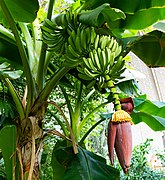


![Original native ranges of the ancestors of modern edible bananas. Musa acuminata (green), Musa balbisiana (orange)[50]](http://upload.wikimedia.org/wikipedia/commons/thumb/c/c5/Banana_ancestors_%28Musa_acuminata_and_Musa_balbisiana%29_original_range.png/250px-Banana_ancestors_%28Musa_acuminata_and_Musa_balbisiana%29_original_range.png)

![Chronological dispersal of Austronesian peoples across the Indo-Pacific[51]](http://upload.wikimedia.org/wikipedia/commons/thumb/e/e4/Chronological_dispersal_of_Austronesian_people_across_the_Pacific_%28per_Benton_et_al%2C_2012%2C_adapted_from_Bellwood%2C_2011%29.png/250px-Chronological_dispersal_of_Austronesian_people_across_the_Pacific_%28per_Benton_et_al%2C_2012%2C_adapted_from_Bellwood%2C_2011%29.png)

